|
===================================================
How To Break 80 Newsletter
January 17, 2007
"The Web's Most Popular Golf Improvement Newsletter"
===================================================
In this issue we'll discuss...
1) Hitting the Long Irons
2) Club Selection Around the Greens
3) Question of the Week- Curing the Shanks
4) Article- The Benefits of Offset Design
5) Article- Five Checkpoints When Playing 18 Holes
===================================================
1) Hitting the Long Irons
===================================================
Long irons are hard to hit. Among the longest clubs in the bag, they give even good players trouble. That's why many weekend golfers replace them with hybrid clubs. Hybrids are shorter and easier to hit than long irons, but they drive the ball just as far.
Unfortunately, not everyone likes hitting hybrids. They can take some getting used to, and not everyone has the patience or inclination to learn how to hit them. Then there are those players who're just not comfortable hitting hybrids. If you're one of these players, you need to learn how to hit the long irons, if you want to take your game to the next level.
Here are 5 tips for hitting your long irons:
-Focus on tempo and timing
-Think low and slow
-Push the club away
-Keep the clubhead low
-Make a full turn
You need excellent tempo and timing to hit long irons well. If you're too quick with your swing using a 1-, 2-, or 3-iron, you'll probably find yourself in trouble after the shot. Since a smooth rhythmic swing is paramount with these irons, you need to think, "low and slow" at address.
To start low and slow, push the club away from the ball with your left arm and hand (for right-handers) at address, keeping the clubhead low to the ground, instead of snatching the club away as you start your backswing. This movement encourages you to make a full turn with your hips and shoulders during your swing.
Maintaining your tempo and timing is key when hitting long irons. By taking the club back slowly and rhythmically, your legs, torso, shoulders, hands, and arms will work in harmony, generating a longer, straighter shot. Think low and slow when you hit the long irons and you'll slice strokes off your golf handicap.
=================================================== 2)
Club Selection Around the Greens
===================================================
Even good golfers make bad choices when it comes to club selection around the greens. Maybe it's because it's a pressure shot. In any case the right selection-along with the right swing-sets up an easy putt, possibly for a par or a birdie. The wrong selection-even with a good swing-leaves a long difficult putt, maybe for a double bogey or worse.
The problem is spin. Using a higher-lofted club puts a lot of spin on the ball, which can be difficult to control. Using a lower-lofted club puts more roll on the ball, so you'll need more room for the shot. Naturally, you want to select the club that's right for the shot.
Two schools of thought exist when it comes to club selection around the greens. Some people use their favorite club for every shot near the green. They simply open up the club's face to generate more loft, and hence, more spin. They then hit the ball harder or softer depending on the shot.
Other people change clubs. If they need a shot with more spin than roll, they'll use a more lofted club, like a sand wedge. If they need a shot with more roll than spin, they'll use a less lofted club, like a 5-iron or a 7-iron. Using a slightly open stance, they'll take an identical swing for both clubs.
Both approaches work, if the shots are executed properly. However, many golfers prefer the second approach because it has fewer variables involved, making the shot easier. You just need to remember to choke down on a lower lofted club for better control.
Ultimately, your approach will be a matter of personal choice. Try both and see which you're more comfortable with, then practice it frequently. Remember using the right club around the greens can be the difference between a par or a birdie and a double bogey or worse.
=================================================== 3)
Question of the Week- Curing the Shanks
===================================================
From Graham Battershill, Surrey, England
Curing the Shanks
Q. Hi, Jack.
I've developed a shank lately on my wedges. This is becoming a real pain, especially around the greens, where I lose shots. Can you help with this situation?
A. That's a good question, Graham. Thanks. There's nothing worse than having the shanks. Even the pros shudder at the mere mention of the word. A shank occurs when a ball is caught in the angle between the clubface and the hosel, spinning the ball sideways.
The problem is that at impact the player's hands-and therefore the clubhead- are farther away from his body than at address. The cause: either standing too close to the ball, preventing your hands from swinging freely past the body, or shifting your weight forward on your toes, throwing your hands and clubface too far from the body.
If weight shift is the problem, curling your toes inside your golf shoes, and maintaining them throughout the swing, cures it. If it doesn't, place a golf ball under the front of each foot, pushing your weight back on your heels, then hit some balls. Maintaining too tight a grip also contributes to the shanks. Gripping the club tightly prevents it from swinging freely past the body through impact.
If your hands are the problem, place a ball about a half-inch outside your ball. Then, try hitting the inner ball cleanly. Try to sense that your hands are closer to your body through impact and that you're going to hit the ball on the club's toe. If you hit both balls, your hands are still too close to the ball. Try exaggerating the feeling until the shanks disappear.
If you've got a golf question you'd like answered, send an email to us at
questions@howtobreak80.com and we'll review it. I can't guarantee that we'll use it but if we do, we'll make sure to include your name and where you're from.
===================================================
If you want to truly discover the secrets of shooting like the Pros and creating a more reliable and consistent swing, check out:
http://www.HowToBreak80.com
P.S. Feel free to share this newsletter with family and friends. If you
would like to subscribe to this newsletter, send a blank email to
break80ezine@aweber.com
===================================================
About the Author
===================================================
Jack Moorehouse is the author of the best-selling book
"How To Break 80 and Shoot Like the Pros!". He is NOT a golf pro, rather a working man that has helped thousands of golfers from all seven continents lower their handicaps quickly. His free weekly newsletter goes out to thousands of golfers worldwide and provides the latest golf tips, strategies, techniques and instruction on how to improve your golf game.
|
Tools To
Help Your Game!
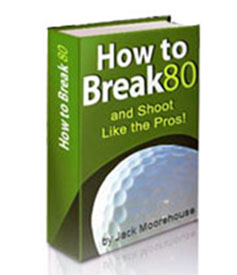
eBook
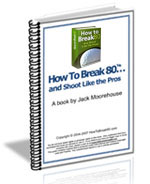
Physical Book
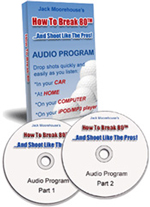
Audio Program
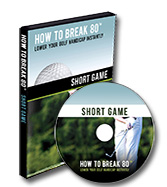
Short Game DVD
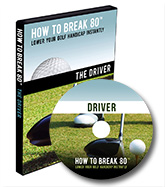
Driver DVD
|